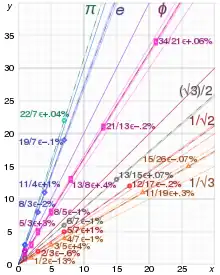
The approximation error in a data value is the discrepancy between an exact value and some approximation to it. This error can be expressed as an absolute error (the numerical amount of the discrepancy) or as a relative error (the absolute error divided by the data value).
An approximation error can occur for a variety of reasons, among them a computing machine precision or measurement error (e.g. the length of a piece of paper is 4.53 cm but the ruler only allows you to estimate it to the nearest 0.1 cm, so you measure it as 4.5 cm).
In the mathematical field of numerical analysis, the numerical stability of an algorithm indicates the extent to which errors in the input of the algorithm will lead to large errors of the output; numerically stable algorithms to not yield a significant error in output when the input is malformed and vice versa.[1]
Formal definition
Given some value v and its approximation vapprox, the absolute error is
where the vertical bars denote the absolute value. If the relative error is
and the percent error (an expression of the relative error) is [3]
An error bound is an upper limit on the relative or absolute size of an approximation error.[4]
Generalizations
These definitions can be extended to the case when and are n-dimensional vectors, by replacing the absolute value with an n-norm.[5]
Examples

As an example, if the exact value is 50 and the approximation is 49.9, then the absolute error is 0.1 and the relative error is 0.1/50 = 0.002 = 0.2%. As a practical example, when measuring a 6 mL beaker, the value read was 5 mL. The correct reading being 6 mL, this means the percent error in that particular situation is, rounded, 16.7%.
The relative error is often used to compare approximations of numbers of widely differing size; for example, approximating the number 1,000 with an absolute error of 3 is, in most applications, much worse than approximating the number 1,000,000 with an absolute error of 3; in the first case the relative error is 0.003 while in the second it is only 0.000003.
There are two features of relative error that should be kept in mind. First, relative error is undefined when the true value is zero as it appears in the denominator (see below). Second, relative error only makes sense when measured on a ratio scale, (i.e. a scale which has a true meaningful zero), otherwise it is sensitive to the measurement units. For example, when an absolute error in a temperature measurement given in Celsius scale is 1 °C, and the true value is 2 °C, the relative error is 0.5. But if the exact same approximation is made with the Kelvin scale, a 1 K absolute error with the same true value of 275.15 K = 2 °C gives a relative error of 3.63×10−3.
Instruments
In most indicating instruments, the accuracy is guaranteed to a certain percentage of full-scale reading. The limits of these deviations from the specified values are known as limiting errors or guarantee errors.[6]
See also
References
- ↑ Weisstein, Eric W. "Numerical Stability". mathworld.wolfram.com. Retrieved 2023-06-11.
- ↑ Weisstein, Eric W. "Absolute Error". mathworld.wolfram.com. Retrieved 2023-06-11.
- 1 2 "Absolute and Relative Error | Calculus II". courses.lumenlearning.com. Retrieved 2023-06-11.
- ↑ "Approximation and Error Bounds". www.math.wpi.edu. Retrieved 2023-06-11.
- ↑ Golub, Gene; Charles F. Van Loan (1996). Matrix Computations – Third Edition. Baltimore: The Johns Hopkins University Press. p. 53. ISBN 0-8018-5413-X.
- ↑ Helfrick, Albert D. (2005) Modern Electronic Instrumentation and Measurement Techniques. p. 16. ISBN 81-297-0731-4